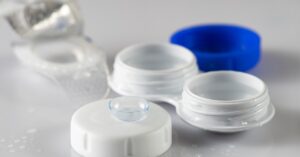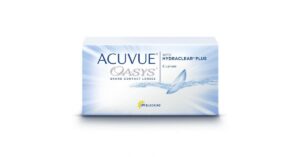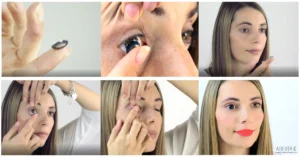Introduction to Contact Lenses
Contact lenses have revolutionized vision correction, providing an alternative to traditional eyeglasses. They offer numerous benefits and are a popular choice for individuals seeking clear, natural vision. Understanding the basics of contact lenses is essential for anyone considering them as a vision correction option.
The Benefits of Contact Lenses
Contact lenses offer several advantages over eyeglasses, making them a preferred choice for many individuals. Here are some of the key benefits of contact lenses:
Natural Vision:
Contact lenses sit directly on the surface of the eye, providing a wider field of view and a more natural visual experience compared to eyeglasses.
Enhanced Appearance:
Contact lenses eliminate the need for frames, allowing the natural beauty of the eyes to shine through. They can enhance your overall appearance, giving you a more natural look.
Freedom of Movement:
Unlike eyeglasses, contact lenses move with your eyes, providing a stable and unrestricted field of view. They don’t obstruct your peripheral vision, making them ideal for sports and other physical activities.
Versatility:
Contact lenses come in various types, including daily disposables, weekly or monthly disposables, and extended wear lenses. This versatility allows you to choose the option that best fits your lifestyle and preferences.
Correcting Different Vision Conditions:
Contact lenses can effectively correct various vision conditions, including nearsightedness (myopia), farsightedness (hyperopia), astigmatism, and presbyopia. There are even specialized lenses, such as toric lenses for astigmatism and multifocal lenses for presbyopia.
Understanding the Basics of Contact Lenses
Contact lenses are thin, curved discs made from materials that are safe and comfortable to wear. They are designed to correct vision by refracting light directly onto the cornea, the clear front surface of the eye. They require a contact lens exam and are available in different materials, such as soft lenses and gas-permeable (GP) lenses, each with its own unique characteristics and benefits.
Soft contact lenses are the most common type and are made from a flexible, water-absorbing material. They conform to the shape of the eye, providing a comfortable fit. Soft lenses are available in various replacement schedules, including daily disposables, weekly or monthly disposables, and extended wear lenses.
Gas-permeable lenses, on the other hand, are rigid and allow oxygen to pass through the lens material to the cornea. These lenses provide excellent visual acuity and are generally more durable than soft lenses. They are often used for individuals with more complex vision corrections or certain eye conditions.
It’s important to note that contact lenses require proper care and maintenance to ensure optimal eye health. This includes cleaning and disinfecting the lenses as recommended by your eye care professional, as well as regular check-ups to monitor the health of your eyes. For more information on how to care for your contact lenses, refer to our article on how to clean contact lenses.
By understanding the benefits and basics of contact lenses, you can make an informed decision about whether they are the right vision correction option for you. Consult with your eye care professional to determine the most suitable type of contact lenses for your specific needs and lifestyle.
Preparing to Insert Contact Lenses
Before putting in your contact lenses, it’s important to ensure that you are properly prepared. This involves washing your hands thoroughly, gathering the necessary supplies, and checking the lens for any damage.
Wash Your Hands Thoroughly
Before handling your contact lenses, it is crucial to wash your hands thoroughly with soap and water. This helps remove any dirt, oils, or bacteria that may be present on your hands, reducing the risk of infection or irritation. Make sure to dry your hands with a lint-free towel to avoid transferring any fibers onto the lenses.
Gather the Necessary Supplies
To insert your contact lenses, gather all the necessary supplies in one place. This includes your contact lens case, contact lens solution, and a mirror. Having everything within reach will make the process more convenient and minimize the chances of dropping or misplacing your lenses.
Check the Lens for Any Damage
Before inserting your contact lenses, take a few moments to inspect them for any signs of damage or defects. Hold the lens up to the light and look for tears, cracks, or irregularities. If you notice any issues, do not use the lens and consult your eye care professional for a replacement. It’s important to ensure that your lenses are in good condition to maintain optimal eye health and comfort.
By following these steps and taking the time to prepare properly, you can ensure a smooth and safe experience when putting in your contact lenses. For instructions on how to remove your contact lenses, refer to our article on how to remove contact lenses. Remember to always handle your contact lenses with clean hands and adhere to the recommended cleaning and care instructions provided by your eye care professional.
Step-by-Step Guide on How to Put in Contact Lenses
Putting in contact lenses for the first time can be a bit intimidating, but with practice and proper guidance, it becomes a routine task. Follow these simple steps to ensure a smooth and comfortable experience:
Step 1: Find a Comfortable and Well-lit Space
Before you begin, make sure to find a comfortable and well-lit space where you can easily see what you’re doing. Adequate lighting is essential for handling contact lenses safely and properly.
Step 2: Open the Lens Case and Remove the Lens
Start by opening your lens case and carefully removing one lens. Avoid touching the lens with your bare fingers to prevent any potential contamination. Instead, use clean, dry fingers or a lens inserter tool to handle the lens. Remember, cleanliness is key when it comes to handling contact lenses.
Step 3: Inspect the Lens for Correct Orientation
Hold the lens up to your eye and inspect it. Contact lenses have a specific orientation, so make sure it forms a bowl shape on your fingertip. If the edges of the lens flare out, it’s inside out. Gently flip the lens over to ensure the correct orientation.
Step 4: Hold the Lens Properly
Using your dominant hand, hold the lens between your thumb, index, and middle fingers. Make sure your fingers are clean and dry to avoid any debris or moisture that could interfere with the lens.
Step 5: Use Your Fingers to Insert the Lens
With your other hand, hold your upper eyelid gently to prevent blinking. Use the middle finger of your inserting hand to pull down your lower eyelid. Look up and place the lens directly onto your eye. Avoid blinking until the lens is in place.
Step 6: Blink and Adjust the Lens if Needed
After inserting the lens, blink a few times to ensure it settles comfortably on your eye. If the lens feels uncomfortable or slightly off-center, use your clean finger to gently adjust its position. If you’re having trouble adjusting the lens, refer to our article on how to remove contact lenses for guidance.
Remember, practice makes perfect, and inserting contact lenses will become easier over time. If you’re still experiencing difficulties or discomfort, consult your eye care professional for assistance. For more information on contact lens care and maintenance, read our article on how to clean contact lenses.
By following these step-by-step instructions, you can confidently put in your contact lenses and enjoy clear vision throughout the day.
Caring for Your Contact Lenses
Proper care and maintenance of your contact lenses are essential to ensure optimal eye health and vision. Here are some important steps to follow when caring for your contact lenses:
Cleaning and Disinfecting
Cleaning and disinfecting your contact lenses is a crucial part of their care routine. It helps to remove debris, protein deposits, and microorganisms that can accumulate on the lens surface. To clean and disinfect your lenses effectively, follow these steps:
Wash your hands thoroughly with soap and water before handling your contact lenses. Be sure to rinse and dry your hands completely to avoid transferring any dirt or bacteria to the lenses.
Remove one lens at a time and place it in the palm of your hand. Apply a few drops of multipurpose contact lens solution to the lens surface.
Gently rub the lens with your index finger in a circular motion for about 20 seconds. This helps to loosen any debris or deposits on the lens.
Rinse the lens thoroughly with the contact lens solution to remove the loosened debris.
Place the lens in a clean lens case and fill it with fresh solution. Make sure the lens is fully submerged.
Repeat the process for the other lens.
Remember to follow the manufacturer’s instructions and replace the solution in your lens case regularly. Avoid using tap water or saliva to clean your lenses, as they can introduce harmful bacteria.
Proper Storage
Proper storage of your contact lenses is crucial to maintain their cleanliness and integrity. Follow these guidelines for storing your lenses:
Always use fresh contact lens solution to store your lenses. Avoid reusing or topping off the solution from the previous day, as it may not effectively disinfect your lenses.
Clean and rinse your lens case with contact lens solution after each use. Let it air dry with the caps off.
Replace your lens case regularly. It is recommended to replace your lens case every three months or as directed by your eye care professional.
Store your lenses in the provided case filled with fresh contact lens solution when you’re not wearing them. Ensure that the lenses are fully submerged in the solution to prevent drying out.
Regular Check-ups with Your Eye Care Professional
Regular check-ups with your eye care professional are essential to ensure the ongoing health of your eyes and the proper fit of your contact lenses. They can assess the condition of your eyes, check the fit of your lenses, and discuss any concerns or issues you may be experiencing.
Additionally, your eye care professional can provide guidance on the appropriate wearing schedule for your contact lenses and recommend any necessary adjustments or changes based on your eye health and lifestyle.
By following these care guidelines and maintaining regular check-ups with your eye care professional, you can ensure that your contact lenses provide you with comfortable and clear vision while keeping your eyes healthy. For more information on contact lens care, check out our article on how to clean contact lenses.
Troubleshooting Tips for Contact Lens Wearers
While contact lenses can greatly improve vision and provide a convenient alternative to glasses, contact lens wearers may encounter certain issues from time to time. Here are some troubleshooting tips to help you address common concerns and ensure a comfortable wearing experience.
Dealing with Discomfort
If you experience discomfort while wearing contact lenses, it’s essential to identify the cause and address it promptly. Discomfort can arise due to various factors, such as dryness, foreign particles, or an ill-fitting lens.
To alleviate discomfort, try the following steps:
Check for debris:
Inspect your lens for any debris or particles that may have become trapped. If you find any, remove the lens, rinse it thoroughly with saline solution, and reinsert it.
Moisturize:
If you have dry eyes, consider using lubricating eye drops recommended by your eye care professional. These drops can help relieve dryness and improve comfort.
Reevaluate fit:
If discomfort persists, it’s possible that your contact lens doesn’t fit properly. Consult with your eye care professional to assess the fit and consider switching to a different lens type or brand.
Handling Dry Eyes
Dry eyes can be a common issue for contact lens wearers, causing discomfort and irritation. To manage dry eyes effectively, try these tips:
Use lubricating eye drops:
Lubricating eye drops specifically designed for contact lens wearers can provide relief from dryness. Apply the drops as recommended by your eye care professional.
Limit screen time:
Spending prolonged periods in front of screens can contribute to dry eyes. Take regular breaks and blink frequently to reduce strain and help maintain moisture.
Avoid environmental triggers:
Certain environmental factors, such as dry or windy conditions, can exacerbate dry eyes. Consider wearing sunglasses or protective eyewear outdoors to shield your eyes from harsh elements.
Addressing Lens Displacement
Lens displacement, where the contact lens moves out of its proper position on the eye, can cause blurred vision and discomfort. To address this issue:
Reposition the lens:
Gently blink a few times to try to reposition the lens back to its correct location on the eye. If necessary, use clean fingers to adjust the lens gently.
Check lens orientation:
Ensure that the lens is not inside out. If it is, remove the lens, rinse it with multipurpose solution, and reinsert it correctly. For a guide on how to tell if a contact lens is still in the eye, refer to our article on how to tell if contact lens is still in eye?
If you continue to experience lens displacement frequently, it may be beneficial to consult with your eye care professional. They can evaluate the fit of your lenses and recommend adjustments if necessary.
Remember, if you encounter any persistent issues or concerns with your contact lenses, it’s always best to seek guidance from your eye care professional. Regular check-ups with an eye care professional are crucial to ensuring the ongoing health and comfort of your eyes.

























